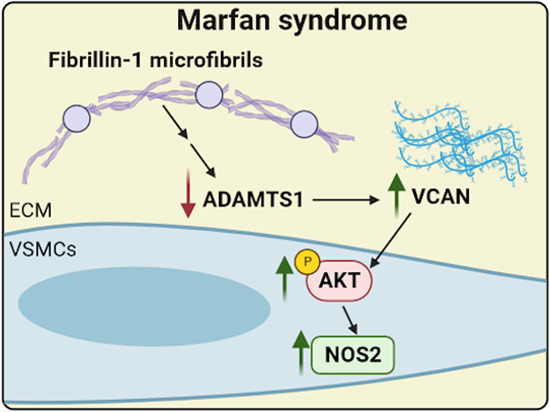- Record: found
- Abstract: found
- Article: found
Versican accumulation drives Nos2 induction and aortic disease in Marfan syndrome via Akt activation

Read this article at
Abstract
Thoracic aortic aneurysm and dissection (TAAD) is a life-threatening condition associated with Marfan syndrome (MFS), a disease caused by fibrillin-1 gene mutations. While various conditions causing TAAD exhibit aortic accumulation of the proteoglycans versican (Vcan) and aggrecan (Acan), it is unclear whether these ECM proteins are involved in aortic disease. Here, we find that Vcan, but not Acan, accumulated in Fbn1 C1041G/+ aortas, a mouse model of MFS. Vcan haploinsufficiency protected MFS mice against aortic dilation, and its silencing reverted aortic disease by reducing Nos2 protein expression. Our results suggest that Acan is not an essential contributor to MFS aortopathy. We further demonstrate that Vcan triggers Akt activation and that pharmacological Akt pathway inhibition rapidly regresses aortic dilation and Nos2 expression in MFS mice. Analysis of aortic tissue from MFS human patients revealed accumulation of VCAN and elevated pAKT-S473 staining. Together, these findings reveal that Vcan plays a causative role in MFS aortic disease in vivo by inducing Nos2 via Akt activation and identify Akt signaling pathway components as candidate therapeutic targets.
Synopsis

Thoracic aortic aneurysms and dissections are common in Marfan syndrome (MFS), a disorder resulting from Fibrillin-1 gene mutations. This study investigates the factors associated with MFS-induced aortopathy in mice.
-
The glycoprotein Vcan accumulates in aortas of both MFS mice and patients.
-
Silencing Vcan, but not Acan, reverses aortic disease and restores aortic Nos2 expression in MFS mice.
-
Vcan activates Akt, and pharmacological inhibition of Akt regresses aortic dilatation and decreases Nos2 protein levels in MFS mice.
-
Elevated pAKT-S473 levels were detected in the aortas of MFS patients.
Abstract
Thoracic aortic aneurysms and dissections are common in Marfan syndrome (MFS), a disorder resulting from Fibrillin-1 gene mutations. This study investigates the factors associated with MFS-induced aortopathy in mice.

Related collections
Most cited references56
- Record: found
- Abstract: found
- Article: not found
Osteoarthritis as a disease of the cartilage pericellular matrix
- Record: found
- Abstract: found
- Article: not found
FBN1: The disease-causing gene for Marfan syndrome and other genetic disorders.
- Record: found
- Abstract: found
- Article: not found